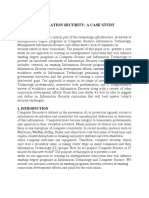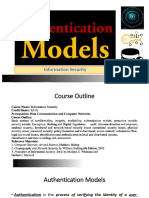Table of Contents using AI
Uploaded by
malikijazawan.businessTable of Contents using AI
Uploaded by
malikijazawan.businessThe EC-Council Certified Incident Handler (ECIH) v3 program is meticulously designed
to equip professionals with the essential skills to effectively manage and respond to
cybersecurity incidents. The course is structured into ten comprehensive modules, each
focusing on critical aspects of incident handling and response. Below is a detailed breakdown
of the modules:
1. Introduction to Incident Handling and Response
• Information Security Threats and Attack Vectors: Understanding various cyber
threats and how they exploit vulnerabilities.
• Attack and Defense Frameworks: Overview of methodologies like the Cyber Kill
Chain and MITRE ATT&CK Framework.
• Information Security Concepts: Fundamental principles of information security,
including risk management and threat modeling.
• Incident Management Process: Steps involved in managing security incidents from
identification to resolution.
• Incident Response Automation and Orchestration: Leveraging tools to streamline
and enhance response efforts.
• Best Practices, Standards, and Legal Compliance: Adherence to industry standards
and legal requirements in incident handling.
2. Incident Handling and Response Process
• Incident Handling and Response (IH&R) Process: Detailed exploration of the
IH&R lifecycle, including preparation, detection, analysis, containment, eradication,
recovery, and post-incident activities.
• Information Sharing Activities: Importance of communication and information
dissemination during incident response.
3. First Response
• Concept of First Response: Immediate actions taken upon identifying a security
incident.
• Securing and Documenting the Crime Scene: Procedures to preserve the integrity
of the incident environment.
• Evidence Collection: Methods for gathering digital evidence systematically.
• Preservation, Packaging, and Transportation of Evidence: Ensuring evidence
remains untampered during handling.
4. Handling and Responding to Malware Incidents
• Preparation for Malware Incidents: Establishing protocols to address potential
malware threats.
• Detection and Containment: Identifying malware presence and preventing its
spread.
• Malware Analysis: Techniques to dissect and understand malware behavior.
• Eradication and Recovery: Removing malware and restoring systems to normal
operations.
5. Handling and Responding to Email Security Incidents
• Email Security Threats: Recognizing phishing, spoofing, and other email-based
attacks.
• Incident Response Strategies: Steps to mitigate and respond to email security
breaches.
• User Awareness and Training: Educating users to identify and report suspicious
email activities.
6. Handling and Responding to Network Security Incidents
• Network Security Threats: Identifying threats such as DDoS attacks, intrusions, and
unauthorized access.
• Incident Detection and Analysis: Monitoring network traffic to detect anomalies.
• Containment and Mitigation: Isolating affected network segments to prevent further
damage.
• Recovery and Post-Incident Actions: Restoring network services and implementing
measures to prevent recurrence.
7. Handling and Responding to Web Application Security Incidents
• Web Application Threats: Understanding vulnerabilities like SQL injection, XSS,
and CSRF.
• Incident Response Procedures: Addressing and mitigating web application attacks.
• Secure Coding Practices: Implementing measures to prevent web application
vulnerabilities.
8. Handling and Responding to Cloud Security Incidents
• Cloud Security Challenges: Identifying risks associated with cloud environments.
• Incident Response in the Cloud: Strategies tailored for cloud infrastructure.
• Data Protection and Compliance: Ensuring data integrity and adherence to
regulatory requirements in cloud settings.
9. Handling and Responding to Insider Threats
• Identifying Insider Threats: Recognizing malicious or negligent actions from within
the organization.
• Mitigation Strategies: Implementing policies to detect and prevent insider threats.
• Incident Response: Steps to address and manage incidents originating internally.
10. Handling and Responding to Endpoint Security Incidents
• Endpoint Threats: Understanding risks targeting end-user devices.
• Detection and Response: Monitoring and responding to endpoint security breaches.
• Endpoint Protection Measures: Deploying tools and practices to secure endpoints.
This comprehensive curriculum ensures that professionals are well-prepared to handle a wide
range of security incidents, safeguarding organizational assets and maintaining business
continuity.
For more detailed information and official resources, please refer to the EC-Council's official
page on the ECIH program.
You might also like
- INT0010A: Corporate C-TPAT Procedure Manual Revised 2015100% (1)INT0010A: Corporate C-TPAT Procedure Manual Revised 20157 pages
- HCLTech Syllabus structure - Amity online MCA Cybersecurity Specialist program v3No ratings yetHCLTech Syllabus structure - Amity online MCA Cybersecurity Specialist program v312 pages
- Cybersecurity CISO Vital Part OperationsNo ratings yetCybersecurity CISO Vital Part Operations11 pages
- Cyber Security Risk Assessment and Management0% (1)Cyber Security Risk Assessment and Management30 pages
- Chapter 3 Reviewer - Information Security ManagementNo ratings yetChapter 3 Reviewer - Information Security Management4 pages
- Networking and Cybersecurity-CURRICULUMmNo ratings yetNetworking and Cybersecurity-CURRICULUMm6 pages
- Section 1 - Cyber Security Introduction and OverviewNo ratings yetSection 1 - Cyber Security Introduction and Overview23 pages
- Unit1 - Introduction and Unit 7 Information SecurityNo ratings yetUnit1 - Introduction and Unit 7 Information Security150 pages
- 1.3 Cybersecurity Techniques and MechanismsNo ratings yet1.3 Cybersecurity Techniques and Mechanisms29 pages
- Cyber Threat Management is an Essential Aspect of CybersecurityNo ratings yetCyber Threat Management is an Essential Aspect of Cybersecurity5 pages
- Instructor Alawi Alhanoni - Training Headlines - NAFTANo ratings yetInstructor Alawi Alhanoni - Training Headlines - NAFTA3 pages
- Cyber Security Expert Masters Program SyllabusNo ratings yetCyber Security Expert Masters Program Syllabus13 pages
- ISACA Cybersecurity Nexus Cybersecurity Fundamentals Certificate ( PDFDrive )No ratings yetISACA Cybersecurity Nexus Cybersecurity Fundamentals Certificate ( PDFDrive )16 pages
- Trellix Arc Threat Report February 2023No ratings yetTrellix Arc Threat Report February 202340 pages
- Threats in the Digital World Cyber Attacks and Data BreachesNo ratings yetThreats in the Digital World Cyber Attacks and Data Breaches7 pages
- Harbingers - Preparation For AVSEC BASIC 2022100% (1)Harbingers - Preparation For AVSEC BASIC 2022142 pages
- Strategic Arms Limitation Treaty (SALT) I and II PDFNo ratings yetStrategic Arms Limitation Treaty (SALT) I and II PDF6 pages
- Information Security 02 - Authentication ModelsNo ratings yetInformation Security 02 - Authentication Models39 pages
- Grok Privacy3 4studentpasswordbookleta4v4No ratings yetGrok Privacy3 4studentpasswordbookleta4v47 pages
- Computer System Security (CSS) KNC - 301No ratings yetComputer System Security (CSS) KNC - 30145 pages
- Managing The Threat: An Introduction To Surveillance Detection100% (2)Managing The Threat: An Introduction To Surveillance Detection5 pages
- A Comprehensive Guide To Network SecurityNo ratings yetA Comprehensive Guide To Network Security8 pages
























































































